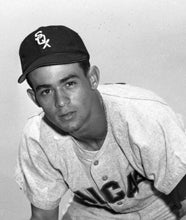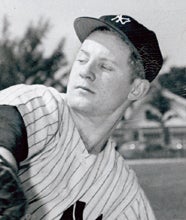- Home
- Our Stories
- Venezuelan pride: Alfonso “Chico” Carrasquel
Venezuelan pride: Alfonso “Chico” Carrasquel
Alfonso “Chico” Carrasquel was one of the great shortstops of the 1950s, as sure-handed as they came in the field and a threat with the bat. So why was the native of Venezuela, then a rookie with the Chicago White Sox, being honored with a “day” at Yankee Stadium? To answer that one must look at the political climate of the time.
This image, taken between games of a doubleheader on July 16, 1950 by acclaimed photographer Osvaldo Salas, shows Yankees manager Casey Stengel (right) accepting a trophy on behalf of his team as a goodwill token from the people of Venezuela. Standing to the left is 24-year-old Carrasquel, the only native Venezuelan in the majors at the time, sporting the gray road uniform of the White Sox, with “Chicago” emblazoned across the front of the jersey.
Yankees manager Casey Stengel (right) accepting a trophy on behalf of his team as a goodwill token from the people of Venezuela. Standing to the left is 24-year-old Carrasquel, the only native Venezuelan in the majors at the time, sporting the gray road uniform of the White Sox, with “Chicago” emblazoned across the front of the jersey. - BL-142-2012 (Osvaldo Salas/National Baseball Hall of Fame Library)
The young shortstop, who was replacing future Hall of Famer Luke Appling on the infield in 1950 and was off to a fantastic start to his big league career, was being honored by his fellow Venezuelans, who numbered more than a thousand among the 21,249 who attended the twin bill. The crowd also included a group of 11-person delegation – including Carrasquel’s mother and sister – who made the 2,500-mile flight from South America to New York.
As part of the day’s ceremony, Carrasquel received a number of gifts, which included a yellow Ford convertible from the Ford dealers of Venezuela; a Rolex watch valued at $2,000 from the Venezuelan government; a set of luggage from Venezuelan fans; two gold medals, a silver medal and a silver insignia; a radio and television; and 16,300 bolivars, a Venezuelan currency worth approximately $5,000.
“Carrasquel Day” was the brainchild of Walter Donnelly, U.S. ambassador to Venezuela, who, it was reported, had suggested this “baseball diplomacy” focus attention upon the United States as a land of opportunity for all.
“Ambassador Donnelly always has been a great believer in baseball as a common denominator among people,” said Frederick Kuhn, press attaché at the U.S. Embassy in Caracas and spokesman for the ambassador. “Therefore, when there recently was an outbreak by the misguided young (Communists) in which they stoned the U.S. Embassy in Caracas, the ambassador felt that something should be done. Since Carrasquel, a native Venezuelan, was doing so well for the White Sox, he hit upon the idea of having a ‘Carrasquel Day,’ with a baseball delegation from Venezuela to participate in it.
“It gave us the opportunity to bring some of the people from the poorer class to the United States. Three players, one each from the eastern, central and western sections of Venezuela, were chosen by lot to make the trip. They will be the best witnesses against Communism that we could find. We have taken them everywhere, shown them everything they wanted to see, with the accent on how our working people live.”
In an April 1951 issue of Collier’s magazine, Donnelly would be quoted as saying, “The reaction to the trip was terrific and I honestly believe it was a severe setback to Communist propagandists in Venezuela. Under no circumstances could a similar trip have been made to Russia or any of the satellite countries.”
As for Carrasquel, he finished that 1950 season having played in 141 games at short, batted .282, which included a 24-game hitting streak, and finished third in the American League Rookie of the Year voting behind Boston’s Walt Dropo and New York’s Whitey Ford. Known as the “The Father of Venezuelan Shortstops” – Hall of Famer Luis Aparicio, Dave Concepcion, Ozzie Guillen and Omar Vizquel would follow – Carrasquel would spend 10 seasons in the big leagues. The four-time All-Star would pass away in 2005 at the age of 79.
Thanks to a generous donation by Rick Swig, almost 900 of Salas’ negatives are now a part of the permanent photographic collection at the Museum.
Reproductions
The National Baseball Hall of Fame and Museum features a collection of nearly 250,000 photographs like this one. Reproductions are available for purchase. To purchase a reprint of this photograph or others from the Photo Archive collections, please call (607) 547-0375. Hall of Fame members receive a 10-percent discount.







